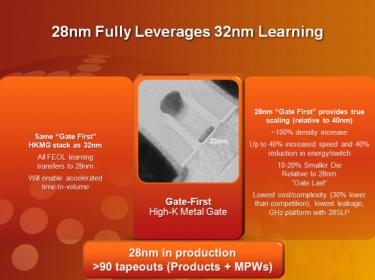 There’s a new blogger in town, Kelvin Low from GLOBALFOUNDRIES. Kelvin was a process engineer for Chartered Semiconductor before moving on to product marketing for GF. His latest post talks about the GF 28nm SLP which is worth a read. There was quite the controversy over this Gate-First HKMG implementation of 28nm that IBM/GF/Samsung uses versus the Intel and TSMC Gate-Last implementation. One of the benefits of the GF version being very low power:
There’s a new blogger in town, Kelvin Low from GLOBALFOUNDRIES. Kelvin was a process engineer for Chartered Semiconductor before moving on to product marketing for GF. His latest post talks about the GF 28nm SLP which is worth a read. There was quite the controversy over this Gate-First HKMG implementation of 28nm that IBM/GF/Samsung uses versus the Intel and TSMC Gate-Last implementation. One of the benefits of the GF version being very low power:
SLP targets low-power applications including cellular base band, application processors, portable consumer and wireless connectivity devices. SLP utilizes HKMG and presents a 2x gate density benefit, but is a lower cost technology in terms of the performance elements utilized to boost carrier mobilities.
Anyway, Kelvin is a great addition to GF’s Mojy Chian and Michael Noonan. I look forward to reading more about customer applications at 28nm and beyond.
28nm-SLP technology – The Superior Low Power, GHz Class Mobile Solution
Posted on September 4, 2012
By Kelvin Low
In my previous blog post, I highlighted our collaborative engagement with Adapteva as a key factor in helping them deliver their new 64-core Epiphany-4 microprocessor chip. Today I want to talk about the second key ingredient in enabling their success: the unique features of our
28nm-SLP technology: Enabling Innovation on Leading Edge Technology
Posted on August 30, 2012
By Kelvin Low
It’s always great to see a customer celebrate their product success, especially when it’s developed based on a GLOBALFOUNDRIES technology. Recently, one of our early lead partners, Adapteva, announced sampling of their 28nm 64-core Epiphany-4 microprocessor chip. This chip is designed on our 28nm-SLP technology which offers the ideal balance of low power, GHz class performance and optimum cost point. I will not detail the technical results of the chip but will share a quote by Andreas Olofsson, CEO of Adapteva, in the recent company’s press release…
Innovation in Design Rules Verification Keeps Scaling on Track
Posted on August 28, 2012
By Mojy Chian
There is an interesting dynamic that occurs in the semiconductor industry when we talk about process evolution, roadmaps and generally attempt to peer into the future. First, we routinely scare ourselves by declaring that scaling can’t continue and that Moore’s Law is dead (a declaration that has happened more often than the famously exaggerated rumors of Mark Twain’s death). Then, we unfailingly impress ourselves by coming up with solutions and workarounds to the show-stopping challenge of the day. Indeed, there has been a remarkable and consistent track record of innovation to keep things on track, even when it appears the end is surely upon us…
Breathing New Life into the Foundry-Fabless Business Model
Posted on August 21, 2012
By Mike Noonen
Early last week, GLOBALFOUNDRIES jointly announced with ARM another important milestone in our longstanding collaboration to deliver optimized SoC solutions for ARM® processor designs on GLOBALFOUNDRIES’ leading-edge process technology. We’re extending the agreement to include our 20nm planar offering, next-generation 3D FinFET transistor technology, and ARM’s Mali™ GPUs…
Re-defining Collaboration
Posted on July 18, 2012
By Mojy Chian
The high technology industry is well known for its use – and over-use – of buzzwords and jargon that can easily be rendered meaningless as they get saturated in the marketplace. One could argue ‘collaboration’ is such an example. While the word itself may seem cliché, the reality is that what it stands for has never meant more…










Quantum Computing Technologies and Challenges